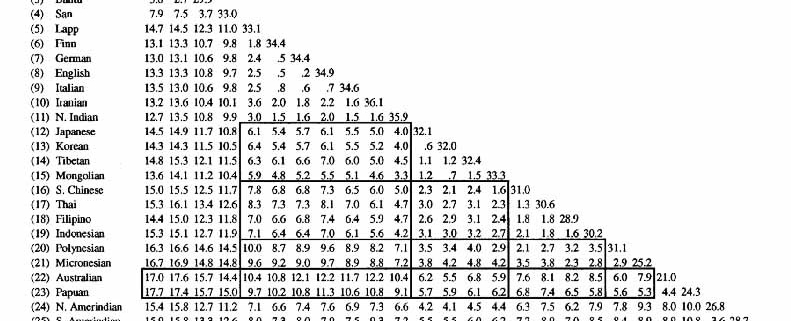Recent Research on Race Realism
Race and Evolution: The Causes and Consequences of Race Differences
Stephen K. Sanderson
Self-published, 2022
Stephen Sanderson is the author, coauthor, or editor of sixteen books in twenty-two editions and some seventy-five articles in journals, edited collections, and handbooks. He is a retired professor of sociology and is quite unusual within his discipline for applying evolutionary principles to the study of society. His latest offering, dedicated to J. Phillippe Rushton, Richard Lynn and Tatu Vanhanen, combines a useful summary of the best in recent research and theory regarding human racial differences (seven chapters) with applications to such topics as the history of slavery, liberal stereotype theory, social stratification by color, the history of human accomplishment, the rise of Northeast Asia, and the decline of Africa (six chapters); a final chapter discusses policy options. Being an American, the author devotes special attention to Whites and Blacks, but includes information on other races wherever helpful.
Sanderson begins his book with several epigraphs that indicate his awareness that he is stepping into a very politically incorrect minefield. These two are well worth pondering in the present context where woke ideology—an ideology based on moral judgments and equitable outcomes rather than science and facts—reigns supreme in universities, the media, and corporate culture:
A good society is one that permits a maximum amount of objective pursuit of truth and beauty, and this pursuit should be undertaken “irrespective of the consequences.” Such inquiry may lead to the discovery of “inconvenient facts,” but it must be undertaken nonetheless. We cannot know in advance whether the knowledge we create or discover will support or contradict certain moral positions already held. And “philosophies incongruent with the pursuit of a reduction in misery should be permitted since the basis of rationality is strengthened through argument,” and “all opinions, however obnoxious or however passionately held, [should] be heard and subjected to the test of rational criticism.” Barrington Moore, Jr.
Political thinking, especially on the left, is a sort of masturbation fantasy in which the world of fact hardly matters. George Orwell
The first section of the book, entitled “Foundations of Race Realism,” will be well-trodden ground for regular readers of The Occidental Observer, so I shall be brief. The first chapter defends the biological reality of races by providing a point-by-point refutation of two high-profile formal statements of social constructivism, one issued by the American Anthropological Association (AAA) in 1998 and the other by the American Association of Physical Anthropologists (AAPA) in 1999. The author explains what is wrong with “Lewontin’s fallacy,” i.e., the inference of the unreality of race from the fact of greater genetic variation within than between racial groups. He quotes some older texts to show that the concept of race was not invented by eighteenth century European colonialists, as the AAA and many antiracists maintain. A good example of the lengths to which some people will go to deny reality is the AAPA’s declaration that “human traits known to be biologically adaptive do not occur with greater frequency in one population than in others.” Sanderson marvels that this is “obviously false and a rather astonishing statement for a biological anthropologist to make,” giving a few simple examples. The chapter closes with an account of how cluster analysis of population genetic data can reliably identify “four to six major racial groups.”
Chapter Two explains the inadequacy of non-biological explanations for differences in racial outcomes, including discrimination, the lingering effects of slavery, and systemic racism. The best of these theories focuses on the higher rates of fatherless households among Blacks than Whites, but the explanation for this difference lies ultimately in racial biology after all.
Chapter Three summarizes evidence for genetically based racial differences in average intelligences. American psychometric data showing an average White IQ of about 100 and an average Black IQ of 85 has now accumulated for over a hundred years. In the course of childhood, the degree to which environment can explain such differences steadily declines, disappearing entirely by around age fourteen. Most damning for the social constructivist position, however, is that Genome-Wide Association Studies (GWAS) now make it possible to identify specific genes that contribute to intelligence, meaning that intelligence can be reliably (albeit not perfectly) predicted from biological data alone. One particularly telling statistic Sanderson cites is the correlation between the average IQ of the nations of the world and the percentage of their population that is Black: –.808.
Many Black-White socioeconomic gaps disappear once IQ is controlled for, but one difference that does not is out-of-wedlock births. In his fourth chapter, Sanderson explains race differences in sex, reproduction and family patterns, summarizing Rushton’s evidence for high mating effort/low nurturance among Blacks and low mating effort/high nurturance among Northeast Asians, with Whites intermediate. He demonstrates that fatherless homes are common in Africa and among Blacks worldwide, not something unique to post-World War II America.
Chapter Five discusses race differences in personality and temperament. In the American context, the most important are that Blacks have significantly higher levels of antisocial personality as well as higher time preference than Whites (i.e., Blacks are more likely to place less value on returns receivable or costs payable in the future and hence more likely to accept immediate rewards rather than wait for larger returns at a later date and more likely to take out disadvantageous long-term loans with immediate up-front payouts). Confusingly, the author systematically switches the terms “high” and “low” time preference; one hopes this mistake can soon be corrected through the print-on-demand system.
Chapter Six explains racial differences in law-abidingness, including violent crime, civil disorder (mob violence), and political corruption. Such differences are in large part a consequence of differences in intelligence and time-preference.
Chapter Seven outlines the historical development of racial differences following the migration of early humans out of Africa and into colder climates where getting through the winter required planning ahead. There is also a discussion of Life History Theory and the r-K continuum (basically the continuum from high mating effort/low nurturance to low mating effort/high nurturance).
The six chapters which make up Part 2 of Race and Evolution apply the race realist perspective to particular issues. Chapter Eight provides a brief history of New World slavery, including regional comparisons, arguing it was fundamentally an economic rather than a racial institution: “Europeans did not choose Africans as slaves because they considered them biologically inferior, but because Africa provided a huge supply of labor that could be transported to the New World more cheaply than slaves drawn from, say, India or China.”
Chapter Nine discusses racial stratification around the world, showing that Blacks have the lowest average socio-economic status in multiracial societies everywhere. The author explains that the phenomenon of “pigmentocracy”—where increasingly light skin is found the higher one goes up the socio-economic scale—results from a hierarchy of ability: “Lighter skinned people are regarded more highly because they are more talented.”
Ever since psychologist Gordon Alport published The Nature of Prejudice in 1954, “stereotypes” have been a staple of social constructivist discourse, the assumption being that they are unreliable. But this has never been demonstrated. In Chapter Ten, Sanderson summarizes the findings of a series of studies published since 2012 by social psychologist Lee Jussim and colleagues. They found a high positive correlation between racial, ethnic, and gender stereotypes and empirical reality. For instance, in one study comparing stereotypes with US Census data, correlations ranged from .27 (already moderately significant) to .96, with a mean as high as .83. Jussim et al. write that “stereotype accuracy correlations are among the largest and most replicable effects in all of social psychology.” This is no doubt because, over human evolutionary history, accurate knowledge of behavior patterns of social groups within one’s environment must have had considerable survival value, and thus been favored by natural selection.
Chapter Eleven demonstrates that the bulk of scientific discovery and other advances in human knowledge have been the work of European and European-descended men. Northeast Asians may have somewhat higher average intelligence, but they tend to produce highly conformist cultures where copying from accepted “masters” is inculcated and originality is frowned upon. Africa, of course, has produced nothing notable in scientific discovery.
Chapter Twelve discusses the recent rapid economic development of Northeast Asia and the dominance of Southeast Asian economies by the overseas Chinese.
Chapter thirteen contrasts this with the catastrophic fate of sub-Saharan Africa since decolonization and demonstrates the inadequacy of anti-colonial theories to explain it. The late Ghanaian economist George B. N. Ayittey has described the typical African post-colonial regime as a “vampire state.” Sanderson summarizes:
A vampire state is one run by crooks and gangsters who come to power either through rigged elections or coups d’état. Their leaders are functional illiterates who debauch all major government institutions: civil service, military, judiciary and banking system. They transform their countries into personal fiefdoms for the benefit of themselves, their cronies and tribesmen.
The author offers a brief tour of the continent filled with collapsing public services, universal corruption and bribery, civil wars, cannibalism, torture, a five hextillion percent rate of inflation (in Zimbabwe a few years ago) and outright genocide (in Rwanda). As he explains:
Before colonialism Africans had indigenous political institutions that were much simpler and more easily used to maintain order than those established by the colonists. The new colonial institutions were not natural to Africans and proved beyond their ability to manage effectively. Indeed, it took Europeans thousands of years to develop such institutions, . . . so it is no wonder that Africans did not understand them.
To this must be added that many who succeed in the ruthless world of African power politics have extremely antisocial personalities and are not really interested in economic development or the general welfare. They concentrate their efforts on enriching themselves at the expense of the countries they govern, displaying “a massive failure to adhere to social norms, no regard for truth, a lack of remorse or feelings of guilt, extreme aggressiveness, impulsiveness and recklessness, and an unusually weak moral sense.”
The final chapter of Race and Evolution is devoted to policy, explaining the failure of racial preferences, the lack of any evidence for the alleged benefits of “diversity,” and the many powerful objections to slavery reparations. Sanderson agrees with law professor Amy Wax’s position that “outsiders’ power to change existing [dysfunctional Black family] patterns is severely limited; the future of Black America is now in its own hands.” Yet he notes that the choices Blacks have to make are constrained by their own biological nature. Some Blacks do make good choices and prosper as a result, but these are generally those with above-average intelligence and an absence of antisocial character traits. Many others are unlikely ever to make better choices than they are making now.
Sanderson agrees that America needs a “national conversation on race,” as advocated, e.g., by Bill Clinton and Howard Schultz (the CEO of Starbucks), but unlike them he understands that it will do no good as long as knowledgeable race realists are banned from participation. As Arthur Jensen and J. Phillippe Rushton have written:
There is a need to educate the public about the true nature of individual and group differences, genetics, and evolutionary biology. Ultimately, the public must accept the pragmatic reality that some groups will be overrepresented and others groups underrepresented in various socially valued outcomes. The view that one segment of the population is largely to blame for the problems of another segment can be harmful to racial harmony. Equating group disparities in success with racism on the part of the more successful group guarantees mutual resentment.
Racial equality of outcome is not achievable, but race relations could be greatly improved if the biological reality of racial differences were understood by more people.
There is not a lot of original material in Sanderson’s Race and Evolution, but I am not aware of any other single volume which summarizes so much useful information about race between two covers. It could do a great deal of good if made widely available. Is there any chance it will be? The author is currently trying to get an e-book version published on Amazon. For the time being, you can order the book directly from him for $12 US plus $4 US shipping (domestic) or 10 EUR plus 7 EUR shipping (outside the United States). Write to:
Stephen Sanderson
460 Washington Road, Apt. G-3
Pittsburgh, PA 15228
E-mail: sksander999@gmail.com
The author also maintains a website at www.stephenksanderson.com.










